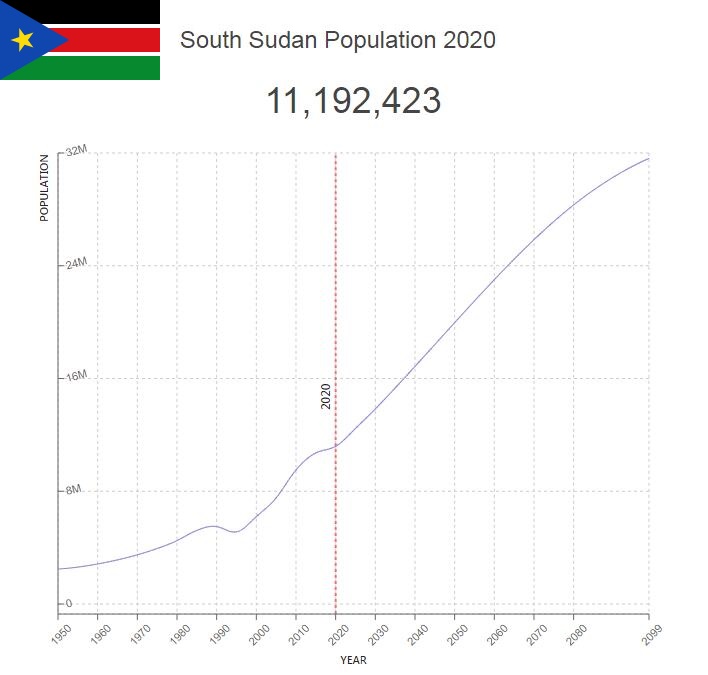South Sudan Population

South Sudan declared independence from Sudan in 2011 and is the youngest state in the world. Since independence, conflicts between different ethnic groups have led the country into a bloody civil war.
Key figures and facts
- Capital: Juba
- Ethnic groups: Dinka 35.8%, Nuer 15.6%, Shilluk, Azande, Bari, Kakwa, Kuku, Murle, Mandari, Didinga, Ndogo, Bviri, Lndi, Anuak, Bongo, Lango, Dungotona, Acholi, Baka, Fertit (2011)
- Language: English (official), Arabic (including Juba and Sudanese variants), regional languages including Dinka, Nuer, Bari, Zande, Shilluk
- Religion: Animists, Christians
- Population: 12 919 053 (2018)
- Control Form: Republic
- Area: 644 330 km2
- Currency: South Sudanese Pound
- National Day: July 9th
Population of South Sudan
The population of South Sudan is estimated at approximately 11.7 million in 2019. That makes South Sudan the 32nd most populous country in Africa. The last official census in South Sudan is from 2008, when South Sudan was still part of Sudan.
It is quite low population density in South Sudan with around 19 people per year. square kilometers. Although there has been an increasing degree of urbanization in recent decades, only about 20 percent of the population lives in urban areas. The largest cities are the capital Juba, as well as Bor, Wau, Yei and Malakal.
The ongoing civil war in South Sudan has caused 2.2 million people to flee to neighboring countries, and 1.9 million are internally displaced. It is estimated that 7.5 million people in South Sudan need emergency aid by 2020.
Population growth is estimated at 2.66 percent for 2019, which is the highest growth worldwide. The birth rate is estimated at 36 per milliliter, while mortality is estimated to be 8 per milliliter. The average age of the population is 18 years. Life expectancy is 60 years for women and 58 years for men.
Population of South Sudan by Year (Historical)
| Year | Population | Annual Growth Rate | Population Density | Global Rank |
| 2020 | 11,193,614 | 1.190% | 18.3218 | 84 |
| 2019 | 11,062,002 | 0.780% | 18.1063 | 84 |
| 2018 | 10,975,816 | 0.600% | 17.9653 | 84 |
| 2017 | 10,910,652 | 0.720% | 17.8586 | 83 |
| 2016 | 10,832,407 | 1.090% | 17.7306 | 83 |
| 2015 | 10,715,547 | 2.420% | 17.5393 | 81 |
| 2010 | 9,508,253 | 4.760% | 15.5632 | 87 |
| 2005 | 7,535,821 | 3.980% | 12.3347 | 94 |
| 2000 | 6,199,283 | 3.910% | 10.1471 | 99 |
| 1995 | 5,117,972 | -1.400% | 8.3772 | 105 |
| 1990 | 5,492,512 | 1.020% | 8.9903 | 95 |
| 1985 | 5,220,636 | 3.000% | 8.5453 | 94 |
| 1980 | 4,502,493 | 2.700% | 7.3698 | 101 |
| 1975 | 3,941,507 | 2.440% | 6.4516 | 102 |
| 1970 | 3,493,893 | 2.200% | 5.7190 | 103 |
| 1965 | 3,133,039 | 1.970% | 5.1283 | 103 |
| 1960 | 2,842,613 | 1.650% | 4.6529 | 102 |
| 1955 | 2,619,601 | 1.080% | 4.2879 | 102 |
| 1950 | 2,482,190 | 0.000% | 4.0630 | 99 |
Major Cities in South Sudan by Population
| Rank | City | Population |
| 1 | Juba | 449,889 |
| 2 | Winejok | 299,889 |
| 3 | Malakal | 160,654 |
| 4 | Wau | 127,273 |
| 5 | Pajok | 48,889 |
| 6 | Yambio | 40,271 |
| 7 | Yei | 40,271 |
| 8 | Aweil | 38,634 |
| 9 | Gogrial | 38,461 |
| 10 | Rumbek | 31,972 |
| 11 | Bor | 26,671 |
| 12 | Torit | 19,937 |
| 13 | Tonj | 17,227 |
| 14 | Maridi | 14,113 |
| 15 | Leer | 10,375 |
| 16 | Tambura | 9,372 |
| 17 | Bentiu | 7,542 |
| 18 | Kapoeta | 6,931 |
| 19 | Raja | 3,589 |
Population Composition
The population of South Sudan is composed of around 60 different ethnic groups. The main weight of the population is nilots, and the largest ethnic groups are dinka, nuer and shilluk. The Dinkas and Nueras are mainly cattle herds, while the Shilluks are settled peasants.
Among the more populous ethnic groups are the Bantu- speaking Azande in the southwest, and their traditional lands also extend into the Central African Republic and the Democratic Republic of Congo. In the southeast, the murals and the Anuak people live, and both of these ethnic groups also include parts of southwestern Ethiopia.
Language
South Sudan’s official language is English. This language was introduced by the British when they ruled the area in the form of the British-Egyptian condominium in the first half of the 20th century.
There are a number of languages that belong to the Nilo-Sahara family, including the Dinka, Nuer and Shillu languages. Azande and other smaller ethnic groups speak different languages belonging to the Niger-Congo family.
Migration
In connection with the many wars, a large part of the population has fled from South Sudan. In the last civil war alone, more than 5 million have fled. Around 2.2 million are still refugees in neighboring Ethiopia, Uganda, Sudan and Kenya.













































